by scott.gillum | Jun 24, 2015 | 2015, Marketing
 John Grant, author of The New Marketing Manifesto, states that, “Authenticity is the benchmark against which all brands are now judged.” If being authentic is that important, why has it been done so poorly by so many? If honesty and trust are foundation elements for building authentic brands, shouldn’t it be easy?
John Grant, author of The New Marketing Manifesto, states that, “Authenticity is the benchmark against which all brands are now judged.” If being authentic is that important, why has it been done so poorly by so many? If honesty and trust are foundation elements for building authentic brands, shouldn’t it be easy?
Business marketers often site issues relating to creating a consistent experience and message across the organization and/or across channels, staying true to the organization’s origins, and/or delivering on brand/product promises. All valid reasons, but perhaps there is another challenge at the core that goes unnoticed, something that inhibits the organizations ability tobe “real.” Aproblem simple in form, but difficult to detect and correct.
Yes, it is the senior executives, marketers, sales folks and service people themselves. The employees, who as humans, are uniquely influenced, and some may say flawed, by their own perceptions, bias, and motivations. Here are a few flaws that inhibit an organizations ability to be authentic:
- Biased views – research has found that executives, for better or worse, create “business personas” and view the world with that “business hat” on. In some ways, we play a “role” at work that fits a title, area of responsibility, or how others view you, that may not be realistic. Are we being fake? Maybe, maybe not, but if we say one thing, and believe something else that may be at odds with our “persona,” we just might be. It’s phenomenon researchers have observed with consumers their actions don’t necessarily match their words. In the business world, we act in a similar manner and may not realize that we are not being completely honest with ourselves, or with our customers…but they know.
- Refusing to recognize or accept change – customer preferences shift, markets fluctuate, competitors enter and exit, and companies evolve. One of the few certainties in business is that change is a constant. The problem is that many organizations are slow to recognize and react to a change. Even worse they flat out ignore it. As a result, companies continue to live in the past, or recognize the need for change and try to shift overnight. Authenticity involves an emotional connection with an audience and that connection is forged over years through consistency. Consistency builds trust and integrity. Ignoring the reality of your audiences’ world, trying to be something you’re not, or telling customers what you think they want to hear, quickly deteriorates trust and erodes integrity. “Keeping it real” involves keeping your head out of the sand and on the lookout for change, for better or worse. It also involves accepting reality as it is, no matter how painful it might be.
- The need for control – trust is a foundation element, and when we feel like it is lacking it sets off a basic human reaction to seek control over a situation. Inversely, when we trust, a handshake, for example, will often do look at the rise of shared economy companies like Uber, Airbnb. For established companies, take a look at the ever-expanding legal language in contracts and evaluate the impact it might be having on eroding trust with customers. In the business-to-business world, there are some situations where people have to trust each other to be successful and/or make progress. If we make it too complicated, we invite doubt and/or skepticism into the conversation making it difficult to create the foundation for a long-term relationship. Additionally, if we have an established relationship with a customer keep an eye on contracting, service agreements, product delivery language, etc.
I’ve only a listed a few of the “flaws” that challenge companies, many more exist, but multiply these by the number of humans (employees) at your company, and the number of channels an audience has to interact with your brand, and you begin to get a sense of the complexity of business marketing.
How do successful companies do it? How do they create and maintain an authentic message, perception, and/or brand, by building and preserving a strong corporate culture, but allowing for flexibility. As Bill Breen writes in Fast Company “To maintain its integrity, a brand must remain true to its values. And yet, to be relevant—or cool—a brand must be as dynamic as change itself.” Or as Shakespeare might say: “To thine own self be true.”
by scott.gillum | May 11, 2015 | 2015, Marketing
Look at the tweet, then read the graphic. Why is the headline on this tweet by Spencer Stuart, “Majority of marketing leaders want to see data-and analysis driven decision marketing on their teams,” and not “Majority of marketing leaders want to see more creative thinking and exploration on their teams?”
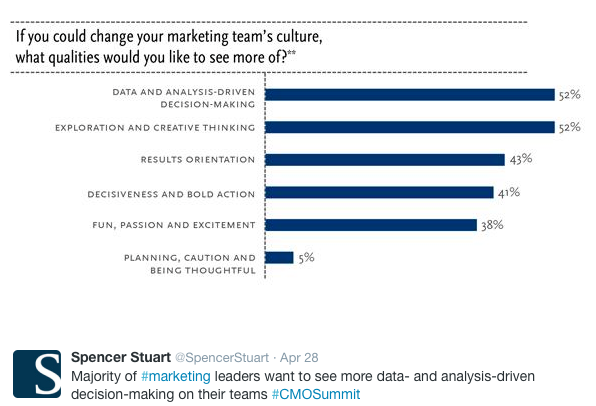
Statistically they’re the same, yet Spencer Stuart emphasized the data/analytic decision making why? “Combine Fun, Passion and Excitement” with “Decision and Bold Action” and you have a solid argument for changing the marketing team’s culture to “Exploration and Creative Thinking.”
On the flip side, only 5% of marketing wants a culture of “Planning, Caution and Being Thoughtful,” amen brother. Ok, I hear you, “if it was “fun” they would call it “play” not work, but maybe we need a little more play at work.
According to Peter Gray, a professor at Boston College and author of Free to Learn, ”play” can be the key that unlocks the mindset of bold creative thinking. In an article on Psychology Today, Gray says that the “alert but unstressed condition” of a playful mind has been shown repeatedly, in psychological experiments, to be ideal for creativity and learning new skills.
“Experiments have shown that strong pressure to perform well (which induces a non-playful state) improves performance on tasks that are mentally easy or habitual for the person, but worsens performance on tasks that require creativity, or conscious decision making, or the learning of new skills.” Although accountants may perform well under pressure, it could be a creativity killer for marketers.
One could conclude then, if an organization too narrowly focuses on “analysis and data driven decision making,” it may come at the expense of “Exploration and Creative Thinking” mentioned in the research and Tweet. Said differently, all work and no play, could make your marketers dull.
Pressure to perform in business marketing is a given, so how do you strike a healthy balance? Stephanie Anderson, CMO of Time Warner Cable’s business division, suggested that by ” focusing on business results first, ensuring that you have a way to show the business impact of marketing activities, you’ll have the foundation in place in order to inject a fun and creativity into the workplace.”
by scott.gillum | Mar 2, 2015 | 2015, Marketing
For business, this is turning out to be the “year of the human.” Andy Goldberg, global creative director at GE, said in an interview with Advertising Age about marketing trends in 2015: “We need B-to-B to be more human.” Karen Walkers, SVP of marketing at Cisco, went ever further by saying, “Devotion to brands begins and ends with an emotional connection. Buyers are people, people are humans and humans are emotional beings.”
Why this sudden awakening of humanity in tech marketing? The recognition that business decision makers are also people with emotional needs? Well, the answer might surprise you, and it’s based on a good bit of data and research.
The CEB (formerly Corporate Executive Board) first picked up on this trend in their research that found communicating business value (functional benefits of a product or service) was not differentiating because perceptions on that value h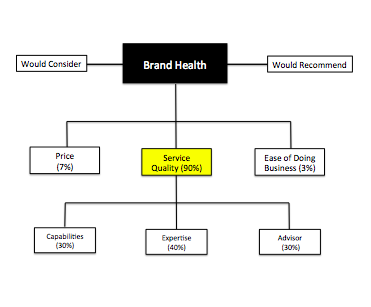 ardly varied between brands.
ardly varied between brands.
For example, a recent brand health study for a tech client found that 90 percent of their brand health (defined by a willingness to recommend and consider) was driven by service quality. Service quality made up 90 percent of the attributes in the graphic.
The smart marketer would think that in order to improve our brand health, we should increase our focus and communication for the performance attributes related to service quality. And they would be right, except for the fact that those business value drivers also apply to all competitors in the category, which is apparent in the graphic below:
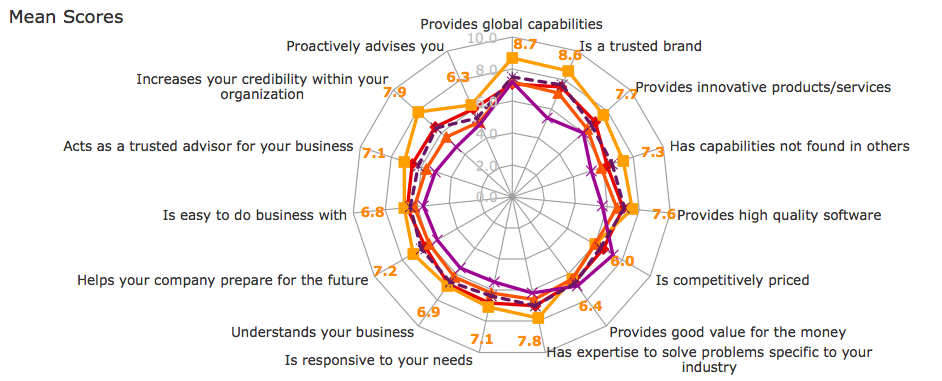
Each color line represents how a competitor scored on performance attributes under capabilities, expertise and strategic advisors. It is almost impossible to distinguish between the five companies represented (except for the competitor in orange, which also happens to have a leading share of market, mind and voice).
What is clear from the research is that rational purchase drivers that communicate business value, although important, are nothing more than “table stakes.” So what creates separation?
The answer: An organization’s ability to build and communicate value based on the understanding of the risk/reward dynamic involved with a purchase decision. The reason: There is a direct correlation between the level of risk and the emotional involvement of the buyer. The higher the risk, the more emotions play a role. Technology purchases are a particularly high risk because they support critical functions within an organization from payroll to customer communications and more.
As a result, personas need to go deeper into understanding the emotional state of buyers as they go through the buying process. Marketers should map the mental state before, during and after the purchase decision, noting the emotions that buyers might be feeling at that time. Here are some key questions to consider as you go through this process:
- What challenge(s) does this purchase decision present for the buyer? It will defer if the buyer is new versus existing. As a marketer, it’s crucial to know how it’s different.
- What personal risks are at stake for this decision maker? Could they lose their job if they make the wrong decision? Invest in understanding their role and their challenges.
- What are the personal rewards for the buyer? Consider how the decision will pay off for them personally. Most often this will be career oriented, but not always.
It’s also important to note that buyers will already have preconceived feelings towards your brand. This may be a benefit or another hurdle to overcome. Our research in partnership with the FORTUNE Knowledge Group found that nearly two thirds of C-level executives said they believe subjective factors that can’t be quantified (including company culture and corporate values) increasingly make a difference when evaluating competing proposals. Only 16 percent disagree. Furthermore, 70 percent believe that a company’s reputation is the most influential factor when deciding what company to do business with.
Buyers trust their gut to make the right decision based on how they feel about a product and/or brand more than we think (and definitely more than we communicate). They make purchase decisions based on emotions, and then justify them with the business value drivers. It’s the emotional connection that triggers the decision and feature/functionality to support it, not the other way around.
What company does this best? It’s Cisco. Research has shown that they are the most emotionally connected customers. Not surprisingly, as Karen Walkers points out, Cisco recognizes that buyers are not just decision makers with budgets, but rather people who are emotional beings.
by scott.gillum | Feb 5, 2015 | 2015, Marketing
Last month (January 6 to be exact,), the Washington, DC area received its first snow of the season. Dropping 3 – 5 inches of snow in the area, it sent school boards scrambling to assess driving conditions and whether to delay opening or closing schools for the day. Most school systems got it right; but one didn’t, and it set off a social media storm that would take over Twitter.
Fairfax County Public Schools (FCPS) in Virginia missed the call and its students (and parents, to some extent) made certain they knew. More snow fell than was forecasted and froze quickly, making the roads and sidewalks treacherous. Close to 30 accidents – including a school bus – were reported during the early morning commute.
Students using the hashtag #closeFCPS expressed their outrage at having to report to class on time in the hazardous conditions. They also became real-time weather reporters by posting videos and photos of snow conditions, roadways and accidents.
 On what was the first day of the Consumer Electronics Show (CES) and the day after the premier of The Bachelor, a bunch of outraged kids in Fairfax County became the top story of the day, trending no. 1 on Twitter nationwide, second worldwide, and received coverage by the Wall Street Journal, Washington Post, BuzzFeed, USA Today, The Huffington Post, as well as making lead story on all the local news channels. And as the day went on, the hashtag took on a life of its own.
On what was the first day of the Consumer Electronics Show (CES) and the day after the premier of The Bachelor, a bunch of outraged kids in Fairfax County became the top story of the day, trending no. 1 on Twitter nationwide, second worldwide, and received coverage by the Wall Street Journal, Washington Post, BuzzFeed, USA Today, The Huffington Post, as well as making lead story on all the local news channels. And as the day went on, the hashtag took on a life of its own.
How’d they do it?
For students who were supposed to be in class, they certainly spent an inordinate amount of time on their smartphones. As a parent of a teenager who attends a school following the snow policy determined by FCPS rulings, I had a first row seat to the social media frenzy. What can their success teach us? Here are five critical components that I observed:
- A common cause – Nothing rallies the Twitter troops more than a common cause. This one was a “no brainer.” A snow day is a rare and precious gift from the snow gods. This was “cause” marketing at its purest.
- A common enemy – The villain of the day was Ryan Mcleveen, a school board member who had developed a strong bond with students through social media (Twitter in particular). Over 41,000 people – many of them students –follow Ryan because he is the first to report school delays and closings…until he didn’t. That’s when the students made him the target of their tweet bombs.
- Short-term objective – Combine a common cause with a short window of opportunity, and you have a heightened sense of urgency to ignite the base and drive the effort.
- Humor – This is what I believe had caused the effort to trend and continue trending well past the decision point for canceling school. The students played a game of one-upmanship with Instagram posts and tweets, with the most humorous being retweeted over and over. As the day progressed, it was the entertainment value rather than the cause that kept the hashtag trending.

- The bandwagon – Once the hashtag trended, teenagers from other school districts, states and even countries jumped in to support the cause and/or to participate in the fun, many having no idea what the hashtag meant.
The Result
Beyond a formal apology from the school board, the students also got their snow day a day later (along with the following two days of delayed starts) while the rest of the school systems in the area were back on a regular schedule. But what they may have gained, more importantly, was influence.
The question is: Were the delays and school closing due to the weather/road conditions, or was it because of the public shaming on Twitter? We may never know, but let’s see what happens on the next snowy day in DC.
Incidentally, that was supposed to be where my story ended. But with snow in the forecast for the following week, I decided to wait to submit this post for obvious reasons. On Tuesday, January 13, the DC area received less than a half an inch of snow. And while other school districts announced a two-hour delay, Fairfax County closed its schools. #FCPSstudents #Winning
by scott.gillum | Jan 12, 2015 | 2015, Marketing
Just in time for the cold and flu season, scientists have recently discovered that the “Pareto principle – the 80/20 rule” applies to infectious diseases. “Super Carriers” who represent 20% of the population, are responsible for transmitting 80% of infectious diseases.
 Superspreaders, like “Typhoid Mary” of the 1900’s, have the ability, although not fully understood, to infect others without falling ill themselves. Come in contact with the one of them, live in a densely populate area, and you’ve got the recipe for a massive outbreak.
Superspreaders, like “Typhoid Mary” of the 1900’s, have the ability, although not fully understood, to infect others without falling ill themselves. Come in contact with the one of them, live in a densely populate area, and you’ve got the recipe for a massive outbreak.
Like viruses, information is spread in similar ways. The importance of “links per node” in social network influence has been studied for years. Research has shown that it’s not the number of links, but rather how “strategically placed” people are in the core of the network, that leads to dissemination of information or disease through a large fraction of the population.
“Typhoid Mary” for example, was a cook in New York City and had an opportunity to infect large groups of patrons with typhoid fever breakfast, lunch and dinner. Readers of The Hot Zone, or Dan Brown’s Inferno, will also be familiar with the concept of geometric progression’s role in the spreading of disease.
Applying these same principals to the distribution of information yields some important insights for content marketers. Given the nuclear arms race going on in content creation and distribution, finding a way to get your message to, and consumed, by targeted audiences is becoming mission critical.
Superspreaders are a perfect route, and represent an opportunity to narrow your message. Think about it this way instead of trying engage 80-100% of your target audience (being everything to everyone) which is a sure fire way to get lost in the noise, you need only to appeal to the right 20%.
How do you find them? It begins with the mind shift of moving from quantity of contacts, to the quality of those contacts…their place in the network. If your organization is set on measuring social media by the number of fans, followers, etc. you’ve got your work cut out.
Find and profile the key influencers in your industry, and/or on a particular subject matter, and don’t solely rely on social media…you’ll end up with “false gods.” Ask the sales force, monitor speakers on industry events, search for authors on the topic, and scan the academic horizon. Once you’ve created your list, study their language.
Now, use your PR and social monitoring tools, as well as other sources, to understand how and what they communicate. Narrow in on those influencers who are in the right position to distribute your content to the right audience, and not those who may have the most followers and/or may be the most active. “Right position” may be related to position to audience, but it may also include, adding validity to your information.
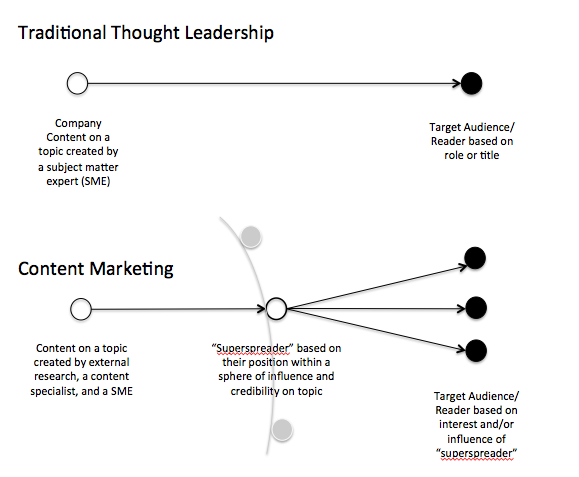
In the digital world, the credibility of the content source is as important, if not more important than, as the actual author/content producer. In the past, companies aimed thought leadership campaigns directly at audience on topics they wanted to communicate. Success with content marketing depends on targeting key influencers with topics that resonate with them in their language so they will pass the information on to their followers.
As a result, you may want to score social spreaders (not a Klout score, use your own ranking) based on their influence (position + credibility). Set a goal for the year to get their attention through a mention or a share, just as you might do with targeted media. Tell your story by designing a content strategy based on the topic areas, language, and the interests of your superspreaders. Then let your “Typhoid Mary or Larry” spread your information…it’s called viral marketing for a reason!
by scott.gillum | Nov 7, 2014 | 2014, Marketing
The 2015 planning season is upon us. It’s the time of year when the C-Suite is busy sharpening their elbows to ready themselves for the budget brawl. To help arm marketers for this blood bath, I’ve pulled together benchmarks and/or research needed to defend and win marketing dollars. Here are some answers, and sources, for your five toughest budget questions.
- How much should we be spending on marketing? It’s a classic question and a favorite of CEO’s everywhere. The mere mention of it is enough to stop marketers in their tracks. Fortunately, the AMA, McKinsey and the Duke Fuqua School of Business have got your back with their 2014 CMO Survey. Section 3 of the report contains data from 350 marketers on their spending from digital to people and programs. The research even breaks spending out by size of company, type of company (B2B or B2C, and B2B products or services). The report is packed with valuable information — it’s a “must have” for any marketer this year.
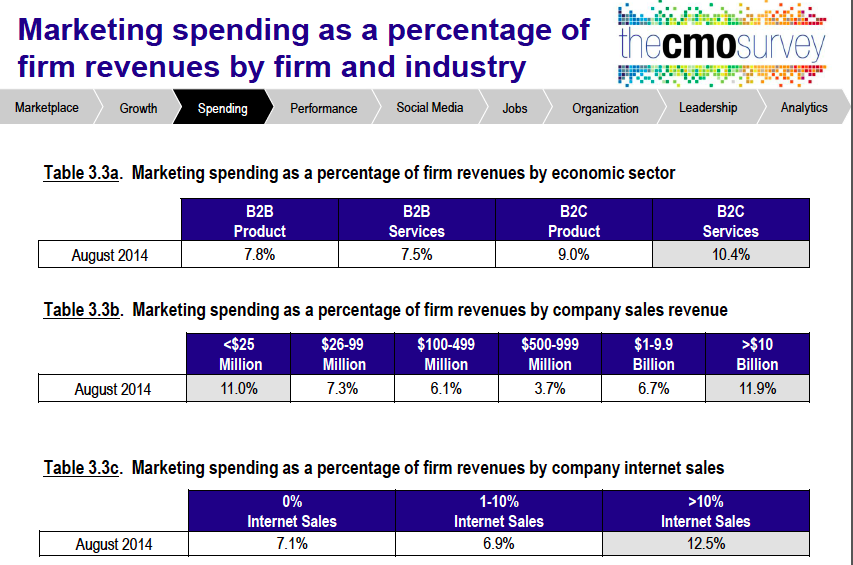
- What should the mix between people and programs? This question comes shortly, if not immediately, after the question above. Ten years ago the general benchmark ratio was 40/60, forty percent of the budget went to staff and the remaining to program spending. Now it’s the reverse, 60/40 people to program spending, for a number of reasons. The biggest factor has been the need for specific skill sets that are in high demand relating to analytics, social media and content marketing have driven up staff cost. Need more information, here’s a useful infographic on the real cost of social media, including salary cost for staff.
- Where should we invest? Typically, this is a teaser question, and could also be asked as; “if you had an incremental $1 (or $10K, $100K, etc.) where would you invest it?” Keep in mind that just because the CEO is asking the question doesn’t necessarily mean you’ll get the incremental funding, but you better be able to answer the question. To do that see IBM’s C-Suite Priorities report entitled The Customer-activate Enterprise. The research, collected from face to face interviews with over 4000 senior executives, provides insights into the priorities of each member of the C-Suite. The top priority in the report is Digital. Including everything from increasing responsiveness to customers, to making the organization more agile and responsive. Specific priorities for CMO’s, it’s about capturing; analyzing and using customer data across touch points.

- What’s the payoff/return/business impact of Social Media? There are a number of sources that you could tab into to help develop a response. I’ve always been a fan of HubSpot’s State-of-Inbound. Additionally, if you have downloaded the CMO Study mentioned in bullet #1, there is a whole section on Social Media (see graphic). Interestingly enough after four years “Visits” and “Followers/Friends” are still the leading social media metrics today. Personally, I’m not a fan, try using measurements related to engagement. Note the gains being made in “Conversion Rates” and “Buzz Indicators” over that last four years. This is the result of the development of better measurement tools. Here’s a great cheat sheet from SocialMediaToday on the Top 50 Tools. For digital and mobile benchmarks download Adobe Digital Index’s Best of the Best Report.
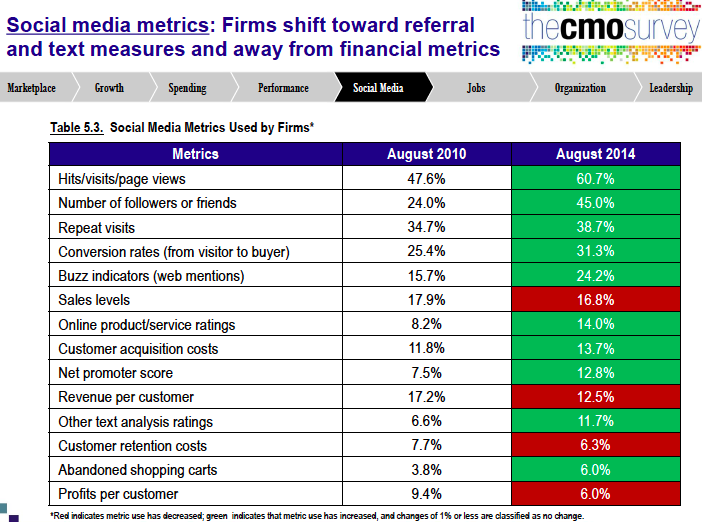
- What return should we expect from our marketing investments? This is a loaded question. Recognize that what the executive really wants to know is: “What will marketing do for me and/or my group?” As a result, answer the question based on their area of interest, and in their language. If it’s a sales executive, talk in terms of new leads, customers and pipeline value. If it’s the CEO, talk about brand value, revenue growth or customer retention or loyalty. Rarely is this question asked on behalf of the organization as a whole. Even more rare, is the executive that believes the numbers you’ve quantitatively derived for a ROI.
Lastly, go in strong and ask for a bigger budget. Here’s a report to keep in your back pocket in case you need it, Gartner’s CMO Spend 2015: Eye on the Buyer. The report will support your request for an increase, and maybe help the “powers that be” understand that if you’re not getting a bigger budget, your key competitors probably are…now go get ‘em!
 John Grant, author of The New Marketing Manifesto, states that, “Authenticity is the benchmark against which all brands are now judged.” If being authentic is that important, why has it been done so poorly by so many? If honesty and trust are foundation elements for building authentic brands, shouldn’t it be easy?
John Grant, author of The New Marketing Manifesto, states that, “Authenticity is the benchmark against which all brands are now judged.” If being authentic is that important, why has it been done so poorly by so many? If honesty and trust are foundation elements for building authentic brands, shouldn’t it be easy?

 ardly varied between brands.
ardly varied between brands.
 On what was the first day of the Consumer Electronics Show (CES) and the day after the premier of The Bachelor, a bunch of outraged kids in Fairfax County became the top story of the day, trending no. 1 on Twitter nationwide, second worldwide, and received coverage by the Wall Street Journal,
On what was the first day of the Consumer Electronics Show (CES) and the day after the premier of The Bachelor, a bunch of outraged kids in Fairfax County became the top story of the day, trending no. 1 on Twitter nationwide, second worldwide, and received coverage by the Wall Street Journal, 










